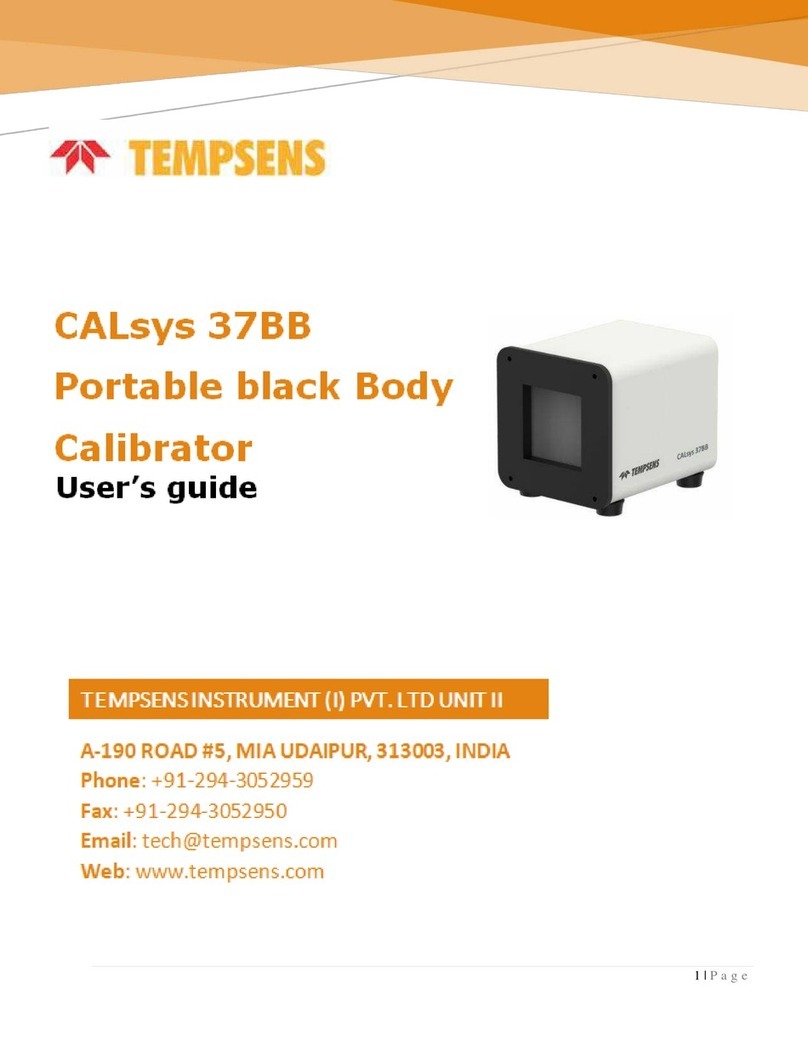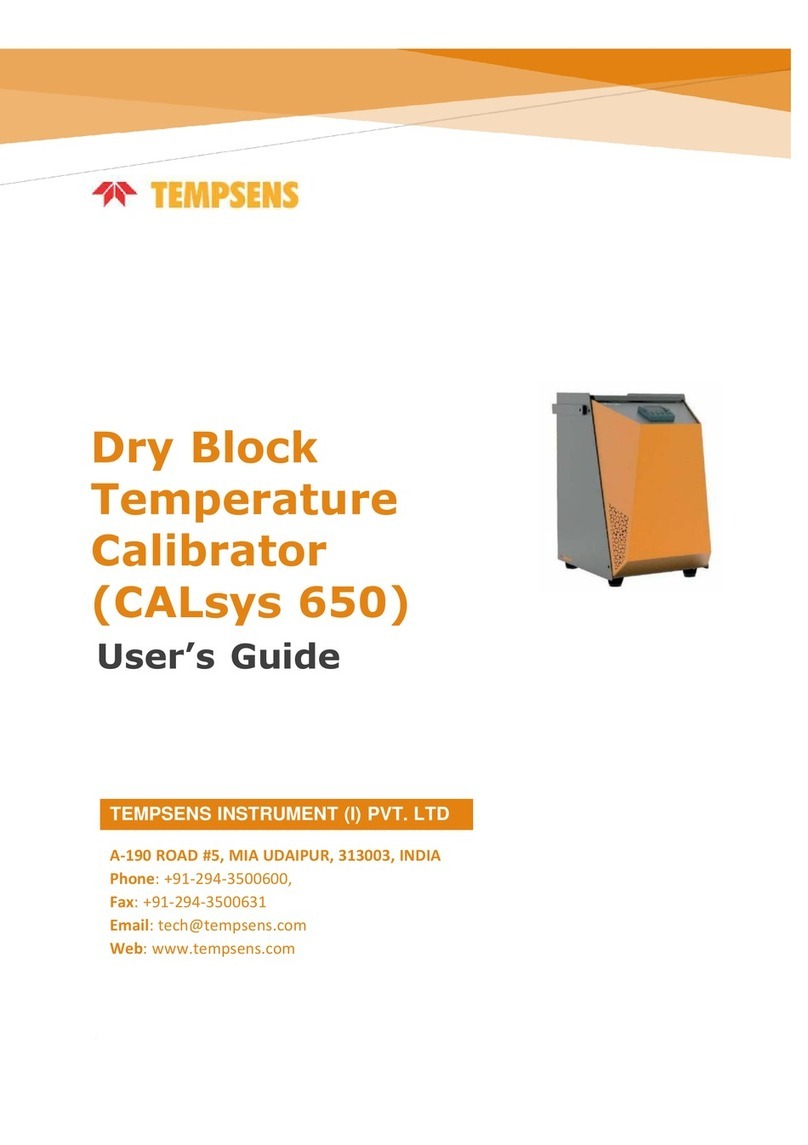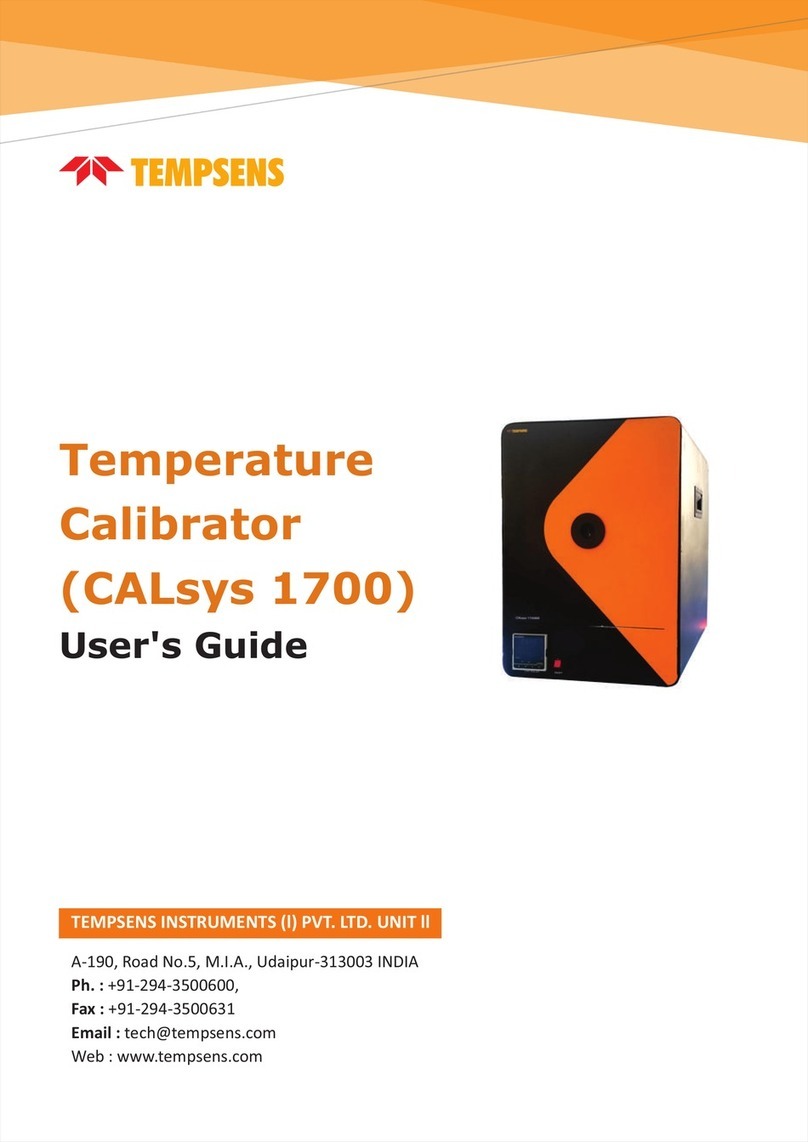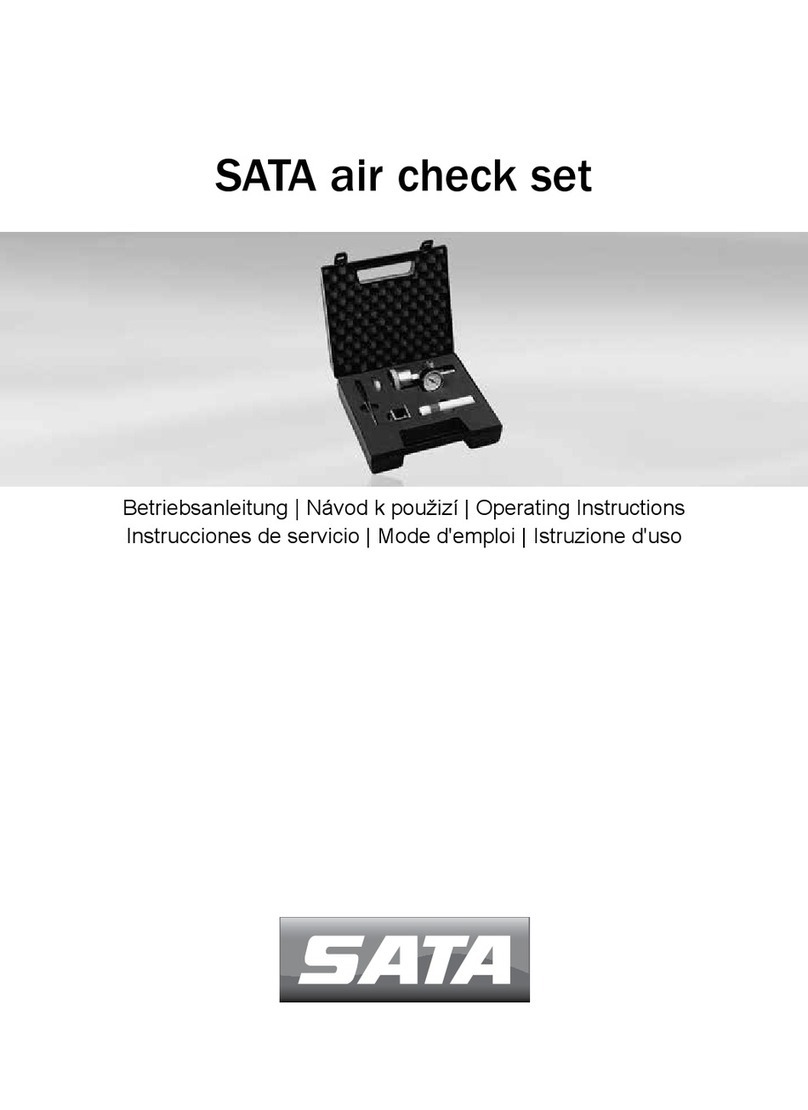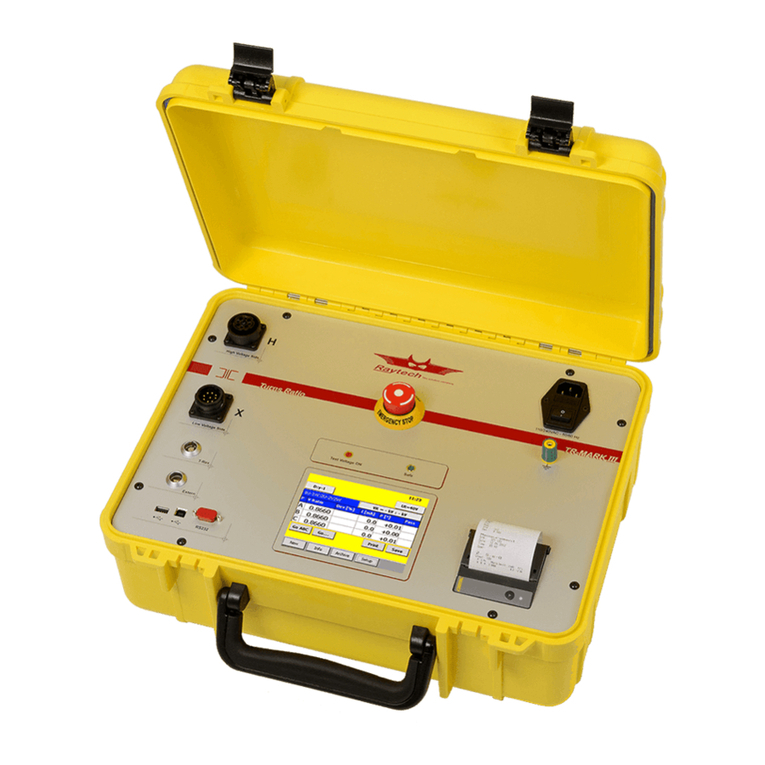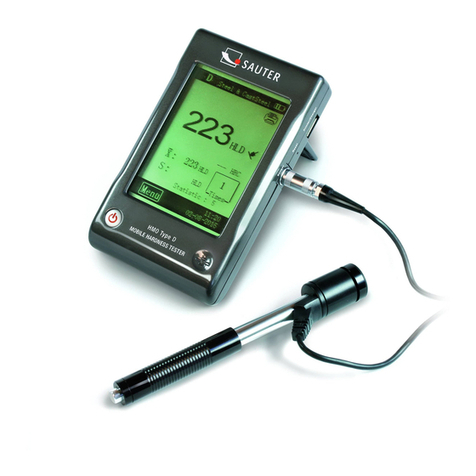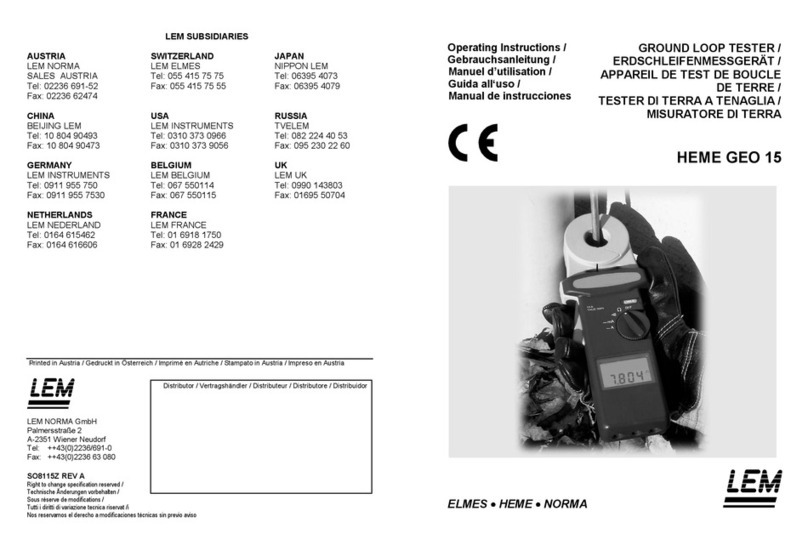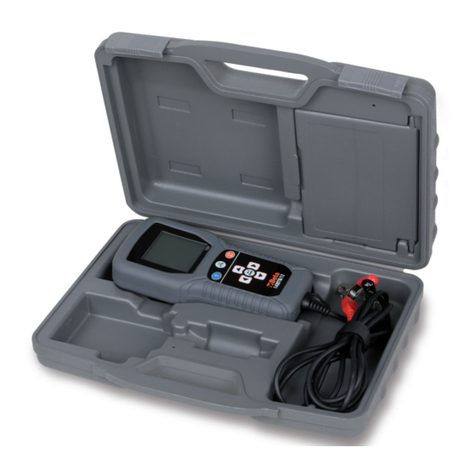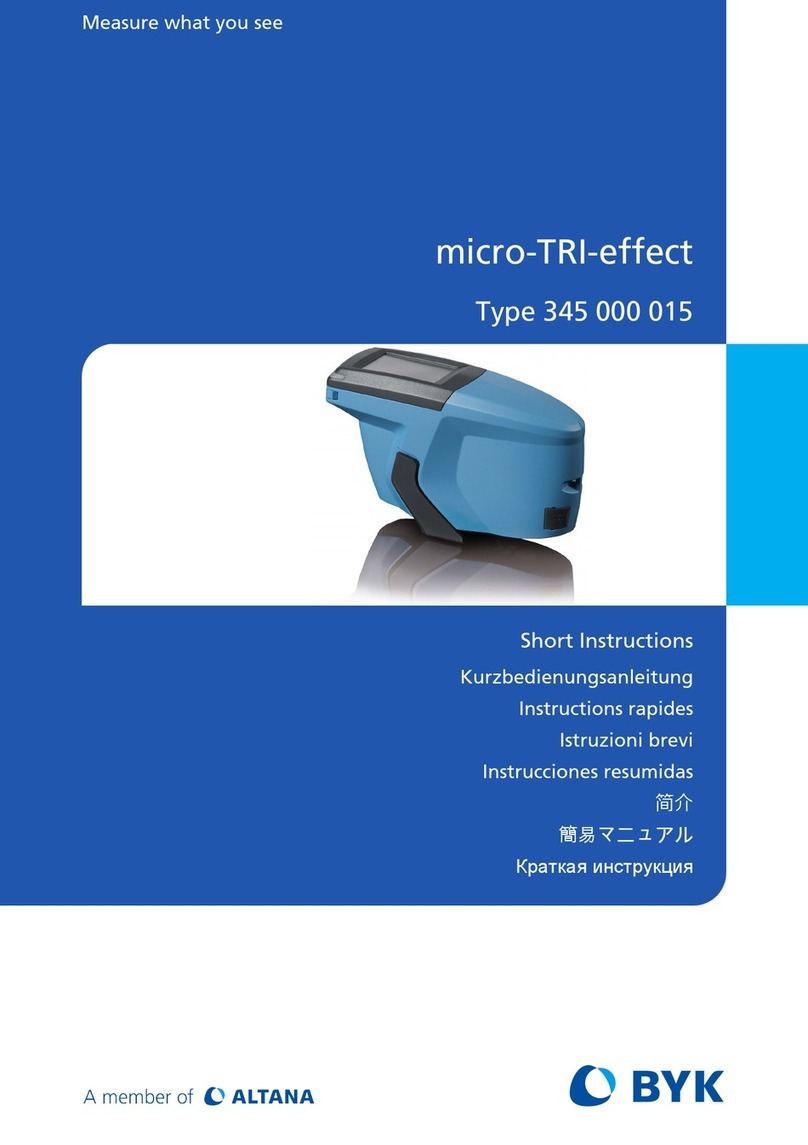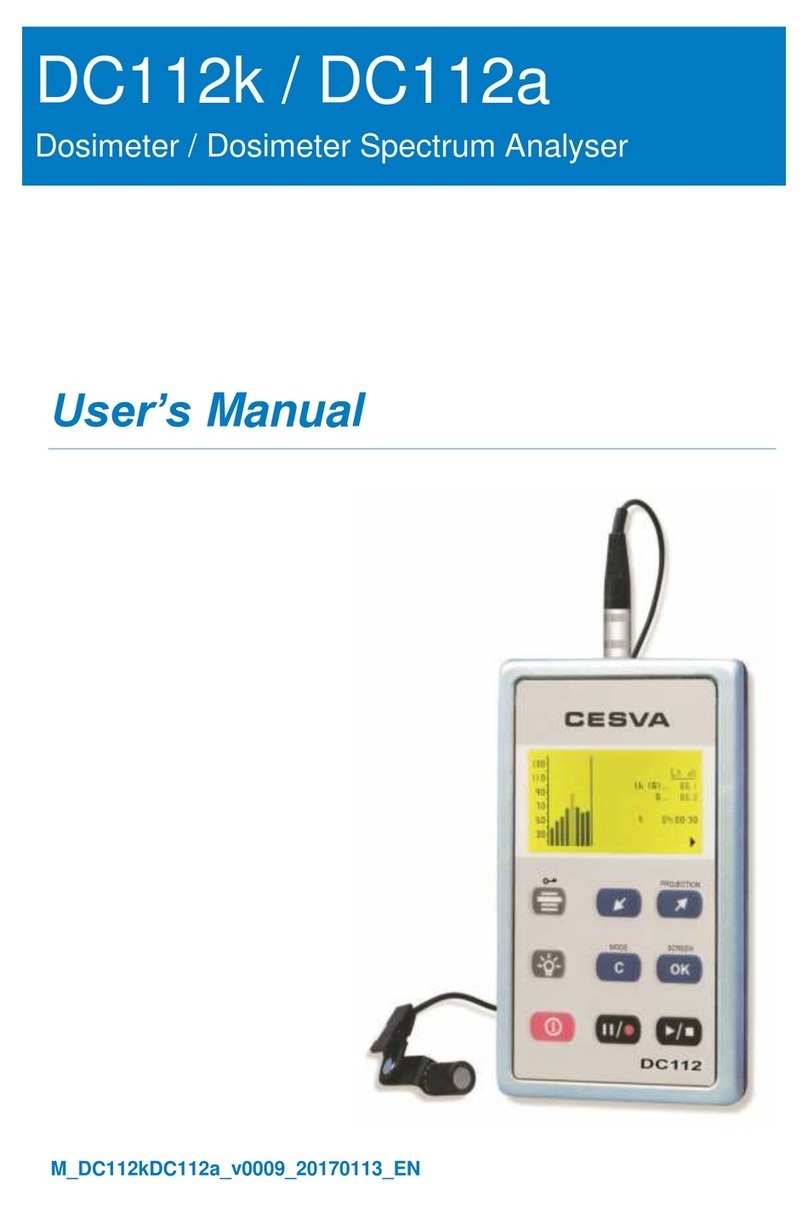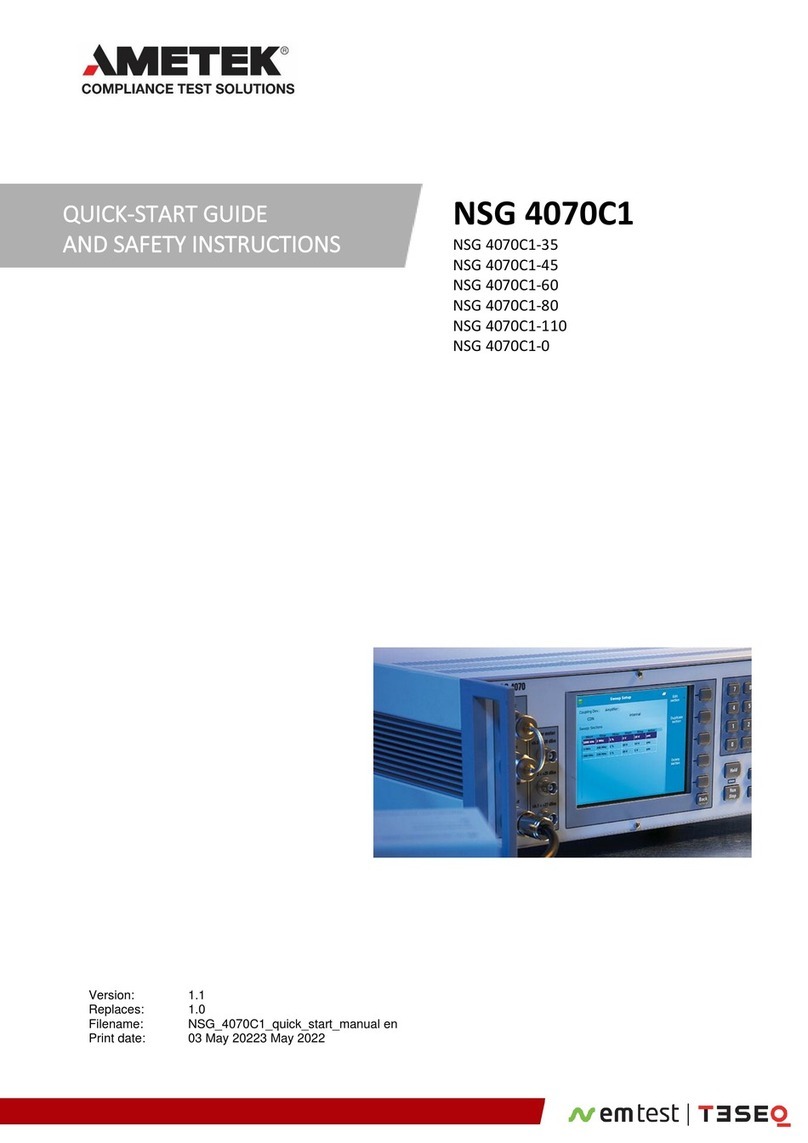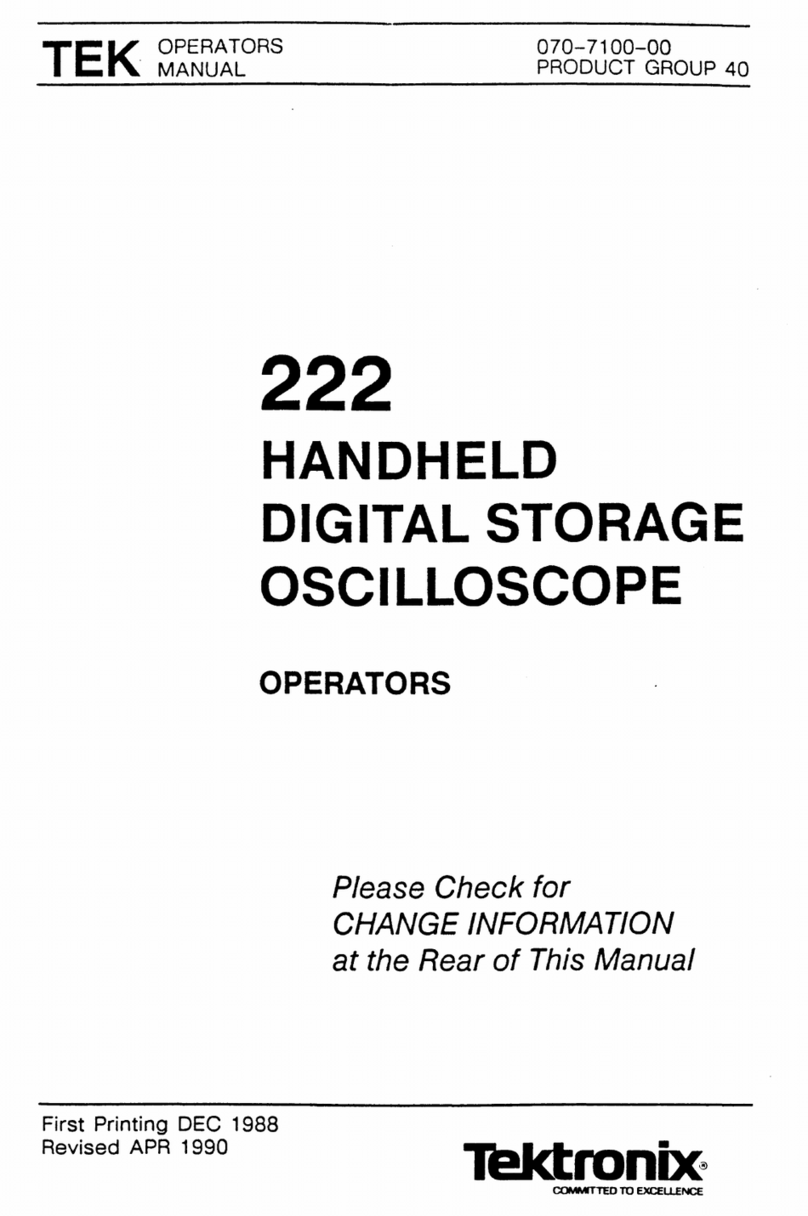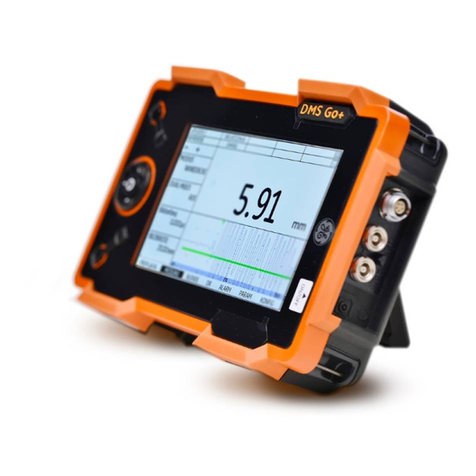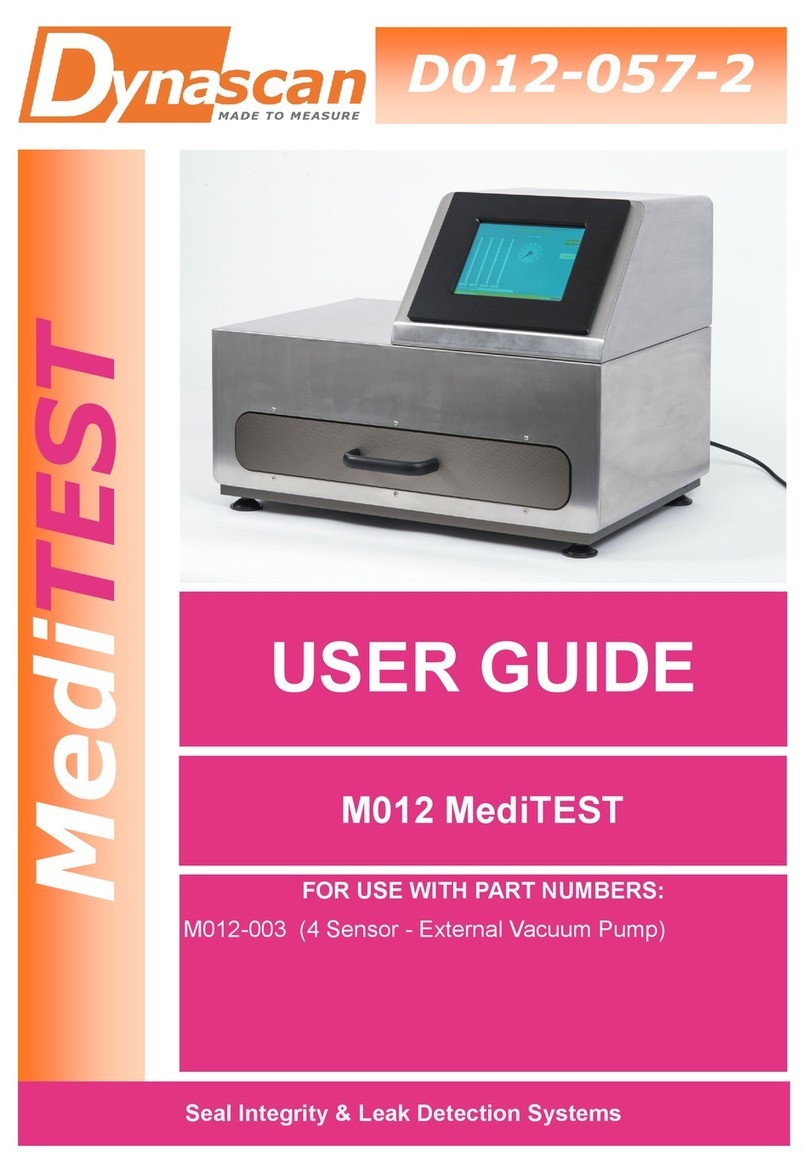Tempsens CALsys -30 User manual

Low Temperature
Dry Block
Calibrator
(CALsys -30/110)
User's Guide
TEMPSENS INSTRUMENTS (l) PVT. LTD. UNIT ll
A-190, Road No.5, M.I.A., Udaipur-313003 INDIA
Ph. : +91-294-3500600,
Fax : +91-294-3500631
Email : tech@tempsens.com
Web : www.tempsens.com

Page | 1
Legal Disclaimer
The information contained in this document is the property of TEMPSENS.
TEMSPENS reserves the right to make changes to this document and to the product described herein
without notice. Before installing and using the product, review the latest version of the applicable
documentation, which are available from the Tempsens website at:
http://www.tempsens.com/
© 2021 Tempsens Instrument Pvt. Ltd. All Rights Reserved.
Document Information
Name
Low Temperature Dry Block Calibrator (CALsys -30/110) User Manual
Document Version
1.0
Document Code
TS.CS.001
Publish Date
Monday, April 11, 2022

Page | 2
Preface......................................................................................................................................... 5
Safety Information.................................................................................................................. 5
Electrical Safety....................................................................................................................... 6
Health and Safety Instructions................................................................................................ 7
Cautions and Preventions....................................................................................................... 8
Document Conventions........................................................................................................... 8
Chapter 1
Introduction................................................................................................................................. 9
1.1 About CALsys30/110............................................................................................................... 9
1.2 Basic Working Model of CALsys -30/110................................................................................. 10
1.3 Physical Measurements.......................................................................................................... 11
1.4 Wiring Diagram....................................................................................................................... 12
1.5 Technical Specifications........................................................................................................... 13
Chapter 2
Setting Up CALsys -30/110........................................................................................................... 14
2.1 Installation.............................................................................................................................. 14
2.2 Optimal Environmental Conditions......................................................................................... 14
2.3 Unpacking and Initial Inspection............................................................................................. 15
2.4 Operating Instructions............................................................................................................ 16
2.5 Initial Testing........................................................................................................................... 16
Chapter 3
Installation of CALsys -30/110...................................................................................................... 17
3.1 Turning on the Unit................................................................................................................ 17
3.2 Heating up the source ........................................................................................................... 17
3.3 Operating Instructions............................................................................................................ 18
3.4 Cooling down the source........................................................................................................ 19
Table of Contents

Page | 3
Chapter 4
Operating CALsys -30/110............................................................................................................. 20
4.1 Front Panel Layout.................................................................................................................. 20
4.2 The Temperature Controller.................................................................................................... 20
4.3 Altering the Set point.............................................................................................................. 20
4.4 Monitoring the Controller Status ........................................................................................... 21
4.5 Temperature Units.................................................................................................................. 21
Chapter 5
Digital Communication................................................................................................................. 22
5.1 Digital Communications Wiring............................................................................................... 22
5.2 Digital Communications Parameters....................................................................................... 23
Chapter 6
Software Installation..................................................................................................................... 24
6.1 Installation.............................................................................................................................. 24
6.2 Parameters on main screen.................................................................................................... 24
Chapter 7
Service & Maintenance................................................................................................................. 26
7.1 Routine Service....................................................................................................................... 26
7.2 Replace the Controlling Sensor............................................................................................... 26
7.3 Replace Solid State Relay......................................................................................................... 26
Chapter 8
Troubleshooting CALsys -30/110.................................................................................................. 27
8.1 CALsys -30/110 unit does not turn on.................................................................................... 27
8.2 CALsys -30/110 unit is not stable........................................................................................... 27
8.3 The temperature of the calibrator does not rise..................................................................... 27

Temperature Calibrator (CALsys -30/110)
User's Guide
Page | 4
Appendix A : Calibration Services ................................................................................................. 28
In House Calibration Facility.................................................................................................... 28
On-site Calibration Facility...................................................................................................... 29
Fixed-Point Calibration Facility................................................................................................ 29
Appendix B : Warranty ................................................................................................................. 30
Limit of Liability....................................................................................................................... 30
Caution in Using the Product.................................................................................................. 30

Page | 5
Preface
Welcome to the Low temperature Dry Block Calibrator (CALsys -30/110) user guide. This guide provides
detailed information about all the product options and features, and explains how to use the product and
configure basic settings to suit your requirements.
This user manual contains information about the product and its proper use and should be kept in a place
where it will be easy to access. This user manual also provides safety precautions in using this product.
Safety Information
This topic contains important information regarding safety. Ignoring safety precautions may cause serious
personal injury or damage to the unit and/or its components. Use the equipment only as specified in this
manual. Otherwise, the protection provided by the instrument may be impaired.
Refer to the safety information in the and sections or wherever specified in this manual.
In order to assure the device operates safely, the operator needs to act effectively and be conscious of safety
problems.
The following definitions apply to the terms “Warning” and “Caution”.
· “Warning” identifies conditions and actions that may pose hazards to the user.
· “Caution” identifies conditions and actions that may damage the instrument being used.
The following safety symbols may appear on CALsys -30/110 unit:
SYMBOL
DESCRIPTION
SYMBOL
DESCRIPTION
Risk of Danger. Important
information. See Manual
Hazardous voltage. Risk of electric shock
Caution, Hot Surface
Protective Earth Ground

Temperature Calibrator (CALsys -30/110)
User's Guide
Page | 6
Electrical Safety
l·This equipment must be correctly grounded before use. Make sure the ground conductor wire
(colored green/yellow) in the main power cable is connected to a protective earth/ground. If the
equipment is not properly grounded, the high voltage may flow through the equipment body
(chassis). SEVERE INJURY OR DEATH may result if personnel fail to observe safety precautions.
l·Do not remove the panels from the equipment without proper safety measures to avoid internal
main power supply voltage hazard.
WARNING:
To avoid possible electric shock or personal injury, follow these guidelines.
This equipment uses protective earth circuit to ensure that the conductive parts do not store electric
charges or conduct electricity if insulation fails.
lBefore connecting the equipment to the electricity supply, understand the parts of the calibrator with
the help of operating manual.
lUse power cables only with appropriate voltage and power rating, and that are approved for usage in
your country.
lReplace the main power cable if the insulation is damaged, or if the insulation shows signs of wear and
tear.
lDO NOT put the product at the location where access to the main power is blocked.
lDO NOT use an extension cord or adapter plug.
lDO NOT use the product if it operates incorrectly.
lMake sure the power cord does not touch the hot parts of the product.

Preface
Page | 7
Health and Safety Instructions
WARNING: BURN HAZARD - DO NOT touch the well access surface of the unit at high temperature
To avoid possible health and safety concerns, follow these guidelines.
lWear appropriate protective clothing before using the equipment.
lOperators of this equipment should be adequately trained in the handling of hot and cold items and
liquids.
lDo not use the apparatus for jobs other than those for which it was designed, that is, the calibration of
thermometers.
lDo not handle the apparatus when it is hot (or cold), without wearing the appropriate protective
clothing and having the necessary training.
lDo not drill, modify or otherwise change the shape of the apparatus.
lDo not use the apparatus outside its recommended temperature range.
lAfter use, do not return the apparatus to its carrying case until the unit has cooled down.
lThere are no user serviceable parts inside. When required, contact Tempsens agent for repair.
lEnsure all materials, especially flammable materials are kept away from the hot parts of the apparatus,
to prevent fire risk.
lDo not use the product around explosive gas, vapor, or in damp or wet environments.
lMake sure that the space around the product meets minimum space requirements.
lDO NOT turn off the unit at temperatures higher than 100°C. This could create a hazardous situation.
Select a set-point less than 100°C and allow the unit to cool before turning it off.
lThe top sheet metal of the furnace may exhibit extreme temperatures for areas close to the well
access.
lMaterials used in this furnace may be irritating to skin, eyes, and respiratory tract. Consult the material
manufacturer's Material Safety Data Sheet (MSDS) to learn about those materials before using.

Temperature Calibrator (CALsys -30/110)
User's Guide
Page | 8
Cautions and Preventions
To avoid possible damage to the instrument, follow these guidelines:
lBefore working inside the equipment, turn the power off and disconnect the power cord.
lDO NOT turn the unit upside down with the inserts in place; the inserts will fall out of the unit.
lUse of this instrument at HIGH TEMPERATURES for extended periods of time requires caution.
lCompletely unattended high temperature operation is not recommended for safety reasons.
lDO NOT plug the unit into 230 V if the heater switches and fuse holder reads 115 V. This action will
cause the fuses to blow and may damage the instrument.
lComponents and heater lifetime can be shortened by continuous high temperature operation.
lDO NOT use fluids to clean out the well.
lNever introduce foreign material into the probe hole of the insert. Fluids and other materials can leak
into the calibrator causing damage.
lDO NOT drop or force the probe stems into the well. This type of action can cause a shock to the sensor
and affect the calibration.
Document Conventions
The documentation uses the following conventions.
Note:
Configuration notes
Tip:
Recommendations or suggestions
Important:
Information regarding required or default configuration settings and product
limitations
WARNING:
Critical actions and configuration options
WARNING:

Chapter 1
Introduction
CALsys -30/110 has been designed to provide stable and accurate temperature to enable professionals to
calibrate temperature sensing devices by comparison method. It is designed to be rugged and easily
maintained. This model provides an isothermal enclosure (aluminum block) in which the
thermocouple/RTD can be calibrated against the temperature of the calibrator.
For traceable calibration, a master calibration sensor should be placed into the aluminum block alongside
the unit under calibration. This method is widely accepted because the calibrator provides very stable
temperature nearing to its controlled point, that is, the Master Thermocouple/RTD. The controlled point is
calibrated by independent laboratory in compliance to the national standards, and compares the sensor
under calibration.
The CALsys models are part of wide range of portable calibrators designed and made by Tempsens.
Contact Tempsens to learn more about other products by Tempsens.
1.1 About CALsys -30/110
Front View Back View
Page | 9

Temperature Calibrator (CALsys -30/110)
User's Guide
Page | 10
The calibrator controller uses a precision RTD as a controlling sensor and controls the well temperature with
thermoelectric cooler. To obtain and maintain a required temperature the controller varies the power to the
Peltier Cell via solid-state relay. There is one electricity driven fan which is situated under the heating
chamber for cooling the heater. The CALsys -30/110 dry block calibrator was designed for portability,
moderate cost and ease of operation. With proper use the instrument should provide continued accurate
calibration of temperature sensors and devices. The user should be familiar with the safety guidelines and
operating procedures of the calibrator as described in the User's Manual.
The calibrator controller uses a precision PT-100 as a controlling sensor and controls the well temperature
with thermoelectric cooler. The CALsys -30/110 dry block calibrator was designed for portability, moderate
cost and ease of operation. With proper use, the instrument should provide continued accurate calibration
of temperature sensors and devices.
1.2 Basic Working Model of CALsys -30/110
Before using the equipment, read the safety guidelines and operating procedures of the calibrator as
described in the of this user manual.
Important:
The basic working model for CALsys -30/110 is as follows:
Desired
Temperature Current
Source Controller Peltier
Cell
Multimeter

Introduction
Page | 11
1.3 Physical Measurement
CALsys -30/110 has the following physical measurements:
Ÿ Height: 383mm
Ÿ Width: 201mm
Ÿ Depth: 285mm

Temperature Calibrator (CALsys -30/110)
User's Guide
Page | 12
1.4 Wiring Diagram
Refer to following figure for CALsys -30/110 wiring diagram.

Introduction
Page | 13
1.5 Technical Specification
CALsys -30/110 has the following technical specifications:
PARAMETER
SPECIFICATION
Temperature Range
-30°C to 110°C
Resolution
0.1°C
Stability
± 0.04°C at -30 °C
± 0.06°C at 0 °C
± 0.07°C at 110 °C
Radial Uniformity
± 0.05°C at -30°C
± 0.07°C at 0 °C
± 0.08°C at 110 °C
Fixed Insert OD dimensions
3 holes of 6.5mm with immersion depth 120 mm
Cooling time
20 minutes (-30°C to 110°C)
Heating time
10 minutes
Resolution
0.1°C
Display
LCD, with °C or °F user-selectable
Power requirements
230VAC, 500W (50Hz)
Calibration
Accredited calibration certificate provided
Environmental operating conditions
0°C to 40°C, 0% to 90% RH (non-condensing)
Specifications valid in environmental conditions
13°C - 33°C
PC Interface
RS-232/ USB
Size (H x W x D)
383(H) x 201(W) x 285(D)mm
Weight
14kg

Page | 14
Chapter 2
Setting up CALsys -30/110
Place the Dry Block on a flat surface with at least 10 inches of free space around the instrument. Overhead
clearance is required.
DO NOT Place this unit under a cabinet or structure. Plug the power cord into a grounded mains outlet
located on the controlling unit rear panel. Observe that the nominal voltage corresponds to that indicated
in the in of this user's guide.Technical Specifications Chapter 1
2.1 Installation
Although the instrument has been designed for optimum durability and trouble-free operation, it must be
handled with care. The instrument should not be operated in an excessively dusty or dirty environment.
Refer to in this user's manual for routine service and cleaning Chapter 7, Service & Maintenance
recommendations.
ŸThe instrument operates safely under the following conditions:
l· Temperature range: 5 - 50°C (41 - 122°F)
l· Ambient relative humidity: 15 - 50%
l· Pressure: 75kPa - 106kPa
l· Main voltage supply within ± 10% of nominal voltage range
l· Vibrations in the calibration environment should be minimized
l Altitude less than 2000 meters
2.2 Optimal Environmental Conditions

Setting up CALsys -30/110
Page | 15
ŸCALsys -30/110 is packed in custom-designed packaging to send out your unit. Unpack the furnace
carefully. Inspect the unit after unpacking for any signs of damage, and confirm that your delivery is in
accordance with the packing note. If you find any damage to the unit or an item is missing, notify Tempsens
immediately
The following accessories are included in the package:
l· CALsys -30/110
l· Power cord
l· RS-232 Cable
l· External Reference Sensor (RTD)
l· Tongue tool
l· Manual
l· Certificates
2.3 Unpacking and Initial Inspection
CALsys -30/110 RTD
RS-232 Cable Insulation wool Power cable

1. Open the carrying case carefully and takeout the operating manual from the box and read carefully.
2. Take out the Temperature Calibrator unit carefully and keep it at suitable place.
3. Connect the power cable to the rear power entry and the power plug to the main power outlet.
4. Turn the switch on, and observe the display on the controller. The display shows that the bath is ready for
use.
5. Keep the switch in the ON position.
6. Ensure the metal INSERT is properly inserted in the bath.
7. Keep the fan in ON position.
8. If the fan is running and temperature of the furnace is rising, the bath is in healthy condition.
2.4 Operating Instructions
lThe unit must be correctly connected to the electricity supply.
lThe unit must be correctly grounded.
lThe unit's ON/OFF switch is located on the power inlet. DO NOT switch OFF the unit when it is hot.
Keep the unit running until cooled.
Note:
This unit is fully tested before dispatching. However, verify its operation as follows:
1. After connecting the CALsys -30/110 to the electricity supply, the temperature controller display should
show the temperature of the chamber, and the last set-point value. The fan on the bottom should be
heard running.
2. Change the set-point to 100°C and observe that the block temperature rises and settles to this value.
3. If the unit performs as expected, the unit can now be used for calibration.
If any problems or faults arise during the test, contact Tempsens immediately for help and advice.
2.5 Initial Testing
Page | 16
Temperature Calibrator (CALsys -30/110)
User's Guide

Page | 17
Chapter 3
Operating CALsys -30/110
3.1 Turning On the unit
1. Before plugging the unit to main power outlet, ensure that the voltage, frequency and current from the
main power outlet are within the recommended rages (typically: 230 VAC±10, 50/60 Hz).
2. Plug the black main power cord into main outlet.
3. Turn the controller on using the switch located on the controlling section, and set the temperature value
in the controller. The Calibrator will turn on and begin to heat the previously programmed temperature
set-point.
PID
CONTROLLER
3.2 Heating up the source
Press “UP” or “DOWN” key of controller to change the set-point value. The controller switches the
calibrator heater to ON or OFF to raise or lower the temperature. The displayed temperature will gradually
change until it reaches the set-point temperature.
The Calibrator may require 15 to 20 minutes to reach the set-point depending on the span. The unit takes
15 to 20 minutes more to stabilize the bath temperature within ± 0.04°C of the set-point.
POWER
ENTRY RS-232

Temperature Calibrator (CALsys -30/110)
User's Guide
Page | 18
1. Connect the CALsys -30/110 to a suitable power supply.
2. Place the metal insert in the bath.
3. Place the sensors for calibration and master sensor into a suitable insert hole.
4. Set the controller to the required temperature.
5. If test and master sensor are thermocouple, then always use compensating cable (for each type such as J,
K, T, E, N, R, S, B) for interconnection between sensor and Digital Multimeter (DMM).
6. Keep reference junction at 0°C. If keeping at 0°C is not possible, then add millivolt (mV) of room
(ambient) temperature with sensors output (mV) to compensate the ambient temperature.
7. When controller temperature becomes stable, record the reading from DMM with at least 41/2 digit
precision, which should be calibrated for the measuring range (mV & ohms measurements).
8. Find out the error by comparison method.
9. Reset the controller and/or repeat the calibration for another calibration point or for another sensor.
10.When the calibration is completed, reset the controller to 0°C. Before moving CALsys -30/110 to new
location the unit must be cooled to below 100°C.
3.3 Operating Instruction
Important:
lWhen the source is operated at any temperature above ambient temperature, the front face and plate
become hot.
lAlways put the fan in "ON" condition and do not switch off the main power supply directly. Before
tuning the unit off, set the controller to 0°C, and then wait until the temperature drops below 100°C.
lAll other controller parameters are set to default, and are locked. It is recommended not to change
these parameters.
Note:
Temperature Block
Insert
Test Sensor
Controlling Sensor
Loading Effect
Stability
Master Sensor
Axial Temperature
Homogeneity
Radial Homogeneity
100.00 100.00

Operating CALsys -30/110
Page | 19
lMetal Insert should be of required hole size so that the hole size is suitable for sensor under calibration.
lAlways use a master sensor (master RTD/TC) for comparison calibration method.
lPlace the metal insert first in all sensors, and then set the controller at desired set point.
lCheck that all sensors (test and master) are immersed at same depth in insert (metal block).
lIf sensors are not immersed at same depth than there will be an error in temperature reading.
lAlways use a metal block calibrator (insert). Metal block calibrator heat transfer characteristics should
match with those in the normal measuring situations.
lThe temperature sensors should be long enough to immerse completely in the calibration bath. Errors
due to stem conduction can be ignored.
lDo not change the set temperature value too often. For example, you set the temperate initially at
100°C, and when it reaches at 80°C, you change the temperature to 150°C. Or, you set the temperature
initially at 150°C, and when it reaches close to 150°C, you change the temperature to 100°C. Doing so
may affect unit's performance.
lPlan the calibration point by gradually increasing temperature, then set the controller accordingly. This
method will save the time.
lTake the reading of sensors (master and test) at stable temperature with the help of digital multi-
meter, or by using Tempsens' TEMPMET 08 or TEMPMET 09 for reading RTD or TC sensor.
Note:
3.4 Cooling Down the Source
lBefore transporting the metal block, ensure that the temperature of bath has cooled sufficiently.
lIf you require metal block to cool quickly, set the temperature to the room temperature (ambient
temperature).
lAlways cool the heated instrument to ambient temperature before disconnecting it from the mains,
switching it OFF, or removing the temperature sensor or test item.
lAlways keep the heated instrument supervised and under observation until it cools down sufficiently.
This manual suits for next models
1
Table of contents
Other Tempsens Test Equipment manuals


